Japan, Australia Ramp Up Amphib Forces: Countering China
Posted on
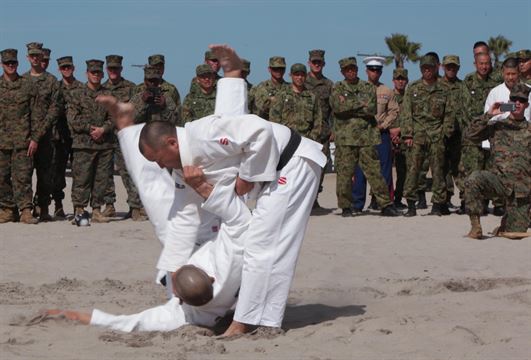
Japanese soldiers of the amphibious Western Army Infantry Regiment conduct a judo demonstration for US Marines.
WASHINGTON: America’s most powerful allies in the Pacific, Australia and Japan, are building up their amphibious forces, buying amphibious vehicles, V-22 aircraft and big new warships. While far smaller than the Marine Corps, the Australian and Japanese units could assist America in stabilizing the region and deterring China — if they can overcome their self-imposed limitations. Japan is preparing for high-end warfare against China, but only in its backyard; Australia is ready to operate more broadly, but not at the high end.
For the first time since 1945, Japan’s military will have the capability to cross the sea, storm a defended beach, and seize an island. That is enough to unnerve both Imperial Japan’s former victims and Japan’s own pacifist mainstream.
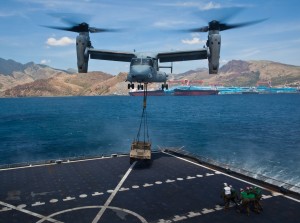
Japan is buying V-22 Ospreys like this Marine aircraft for its new amphibious force.
It’s true that Japan reinterpreted Article 9 of its Constitution to permit “collective self-defense” actions beyond its own territory. Nevertheless, Tokyo insists the new amphibious regiment — ultimately to grow to a brigade — exists only to retake Japan’s outlying islands from any aggressor (i.e. China) who might seize them. So the challenge with Japan will be coaxing the island nation to employ its new amphibious forces more widely across the Pacific region, for example to assist the militarily fragile Philippines.
“Our amphibious brigade is designed to defend our territory, not the South China Sea,” emphasized Col. Masashi Yamamoto, the Japanese army attaché in Washington, when asked about a potential South Pacific mission at the Center for Strategic and International Studies yesterday.
Australia poses the opposite problem. Its amphibious efforts are all about projecting power beyond its territory. In fact, it was the logistical difficulty of sending and sustaining a modest peacekeeping force in East Timor in 1999 that awakened Australian policymakers to the need for more amphibious capability.
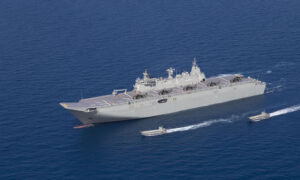
Australian amphibious warship Canberra
“Frankly speaking, the government at that time was pretty appalled,” said Andrew Shearer, former Australian national security advisor, speaking at CSIS. “This whole operation was held together with chewing gum and rubber bands.”
So, after 15 years of effort, Australia has commissioned the biggest naval vessels in its history, a pair of 27,000-ton Canberra-class amphibious ships. Each can carry over 1,000 troops and eight helicopters, making them slightly larger than the US LPD-17 San Antonio class (25,000 tons, 800 troops, four helicopters). Few nations has such capability to carry large amphibious forces overseas.
But while Australia envisions an amphibious force with greater range than Japan’s, it will have less punch. Storming ashore and (re)taking territory is the core mission of the nascent Japanese brigade, but it’s not in the Australians’ portfolio.
“The stated goal,” said Shearer, is an amphibious force capable of “HADR [humanitarian assistance/disaster relief], stabilization operations, and at the upper end of the goal, landing in what you might call uncertain environments. You’ll note that’s what’s envisaged doesn’t go to the highest end of capability, a contested landing.” Moving up to higher-intensity warfare is a much longer-term proposition.
So while the challenge with Japan will be persuading them to operate beyond their own home waters, the challenge with Australia will be persuading them to prepare for all-out warfare. But those are challenges for the long term. Right now, both countries are really just getting started.
“Japan’s ahead of us on this curve,” said Shearer.
Just minutes later, Yamamato said, “our amphibious capability is in the kind of phase zero stage.”
While the two countries’ amphibious are very different from each other, let alone from the United States, they can benefit from training together. Whether you’re delivering aid, rescuing hostages, or storming a defended beach, “the basic tactical skill is the same,” said Yamamoto: the logistics of loading and unloading an amphibious ship; establishing communications between ship, shore, and aircraft; maintaining vehicles’ condition and troops’ skills while cramped aboard ship.
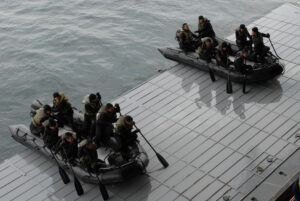
Japanese soldiers of the Western Army Infantry Regiment train for amphibious operations.
Both countries are using army units to build their amphibious forces, rather than creating a separate Marine Corps like the US (or for that matter South Korea). Japan in particular is taking a rapid-deployment force, the Western Army Infantry Regiment — designed to reinforce islands before a Chinese try a land-grab — and upgrading it into an amphibious assault regiment to retake islands after the Chinese seize them. A second regiment will be assembled from unspecified sources in 2018, with the ultimate goal of a full amphibious brigade. (Additional forces will take over the rapid-reinforcement mission). To equip this force, the Japanese are buying 17 American V-22 Ospreys — long-range, high-speed aircraft able to take off and land like a helicopter — and 52 Amphibious Assault Vehicles — armored troop carriers that can swim in the water or drive on land.
To support amphibious operations, the Japanese navy has four helicopter carriers, two of them the new 24,000-ton Izumo class, but these aren’t troop carriers like the Australian Canberras. Japan has three Osumi-class amphibious warships, but these only accommodate 330 troops apiece, which means it would take all three to equal the 1,000-plus troops aboard one Canberra. So sheer troop-carrying capacity will impose a limit on Japanese amphibious operations, especially over long distances where shuttling the same ship back and forth is impractical.
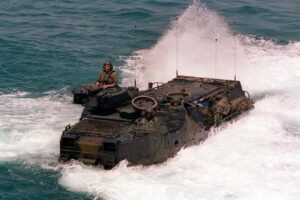
Japan will buy the US Marine Corps’s current Amphibious Assault Vehicle.
Then there’s the possibly China might simply sink the ships before any Japanese troops can land. “My concern there is they’re getting too close to the flame,” said Andrew Krepinevich, former longtime president of the Center for Strategic & Budgetary Assessments, who’s had many conversations with Japanese policymakers. Reinforcing islands during a crisis to deter China is doable, he said, as is defeating low-level incursions by Chinese fishing boats or Coast Guard vessels — the Pacific equivalent of Vladimir Putin’s deniable “little green men.” But once China’s military has permission to open fire, he said, “it’s going to be extremely difficult for them to reinforce those islands once the war starts or to retake them.”
A better way to defend Japan’s outlying islands, Krepinevich argues, is with long-range missiles — anti-air, anti-ship, and, in case the Chinese still get ashore, anti-ground target. Japanese and Australian amphibious troops should instead act as a mobile reserve, shoring up militarily weaker allies like the Philippines.
Of course, the last time Japanese troops landed in the Philippines, they conquered the place. Memories of this ordeal — in both countries — will complicate cooperation against China as much as any strictly military matter.
Subscribe to our newsletter
Promotions, new products and sales. Directly to your inbox.
